Like most kinds of clothing, men’s pants sizes use a unique sizing system that may seem confusing at first glance. Unlike women’s sizing, men’s pants use a measuring system based on inches. The good news is that you can easily learn how men’s pants sizes work by checking out this handy guide!
Men’s pants sizes appear in inches, formatted with the waist measurement first, followed by an X, and then the length measurement in inches. The length for men’s pants uses the inseam measurement. Other important measurements to understand men’s pants sizes include the rise and the outseam.
In this article, you will learn how to read the numbers in men’s pants sizes. You will find out how to take measurements to get the right size of pants for you. Finally, you will find answers to common men’s pants size questions.

Quick Navigation
- What Are Pant Sizes?
- How Do Men’s Pant Sizes Work?
- How Do You Read Men’s Pants Size?
- Men’s Pant Sizes: Complete Guide
- Pants Measurement Size Chart
- Does Length or Width Come First in Pants?
- Is a Men’s Size 34 a Medium or a Large?
- Men’s Jeans Size Chart
- Common Men’s Pants Sizes Explained
- Men’s to Women’s Pants Size Converter
- European Pants Size Conversion Chart
- Conclusion
What Are Pant Sizes?
Pant sizes tell you the circumference of the waist and the length of the leg to help you find the right fit for your body.
In the United States, pants commonly use three different sizing systems:
- Men’s pants, like trousers and jeans, use a sizing system that lists inches. This makes sense because you can easily measure your body and see if the inches around your waist match the inches in size!
- Both men’s and women’s pants, like sweatpants and leggings, often use a less clear-cut sizing metric based on the generic small, medium, and large system.
- Women’s pants sizes typically use a numeric code of even numbers starting at 0 and going up.
How Do Men’s Pant Sizes Work?
Men’s pants sizes tell you the waist size and leg length in inches to give you a precise idea of how the trousers will fit. It takes much of the guesswork out of buying trousers because you do not have to wonder if a small from one brand will fit you in the same way as a small from another brand–instead, just make sure the size lists the same inches from one brand to another!
That said, you will learn how differences in the rise and outseam can influence the size of a pair of pants later in this article, so it is always a good idea to take your measurements and compare them to a sizing chart offered by the brand you like as well.
How Do You Read Men’s Pants Size?
You can easily read men’s pants sizes if you know that the first number tells you the waist circumference and the second number in size tells you the leg length.
Men’s pants sizes appear as two numbers separated by an X, a space, or a dash, like this: 34 X 32, 34 32, or 34-32. In this example, you know from the size numbers that these trousers or jeans have a waistband with a circumference of 34 inches and a length of 32 inches.
The key thing to remember here is that the waist size is always listed first, followed by the length.
Also, the length does not mean the entire distance from the waistband of the pants to the ankle. Instead, this measurement refers to the inseam length, which you can read about in the next section!
Another thing to keep in mind about pants sizing is that most brands also offer a fit description or fit the label. This tells you how wide the opening at the ankle is and how high up your waist the waistband will reach.
You have probably seen fit descriptions such as “skinny,” “boot cut,” or “slim straight” before. These do not technically tell you the size of the pants, but they do help you understand how the pants will fit your body.
Men’s Pant Sizes: Complete Guide
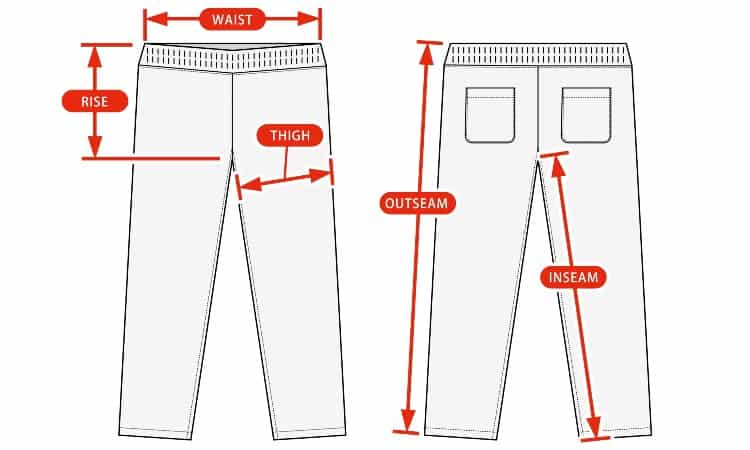
The key areas of measurement for men’s pants sizes are the waist and the inseam. The rise and the outseam measurement can also help you find pants that fit perfectly, but you usually have to look at a sizing chart for these two measurements as they are not included in the numeric size label.
1. Waist
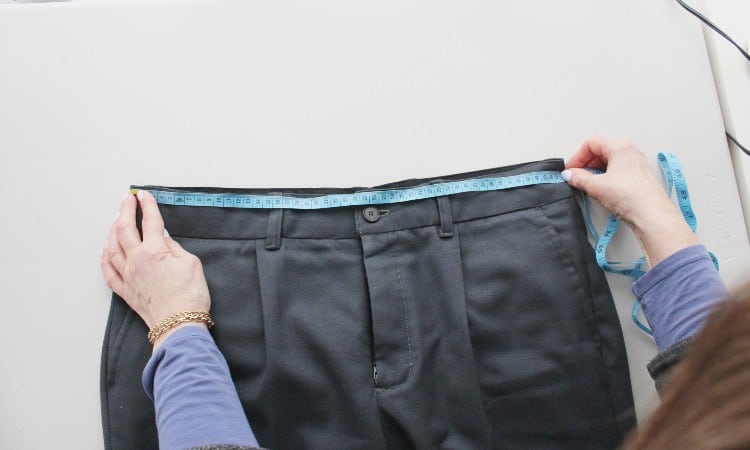
The waist measurement is probably the single most important number to know in men’s pants sizes. Men’s pants size list this number first, in inches. The waist measurement tells you what size of waist the pants waistband should comfortably fit.
But–and this is a large but–the measurement listed in the pants size may not match the circumference of the waistband in inches. This is because many pants styles have a waistband that may fall at your natural waist, at your navel, or even at your hips!
For this reason, manufacturers list the waist size on the pants that should match your natural waist, not the point where those pants will fall on your body. In practical terms, this means that if you have a 32” natural waist, you should always look for pants that list 32 inches as the first part of the size, even if the garment has a waistband that rides down around your hips.
Measuring your own waist only takes a second.
- Use a flexible tape measure like the kind you can get in a Dollar Store sewing kit.
- Stand in front of a mirror with your feet planted on the floor and your shoulders straight.
- Find your natural waist, often the narrowest portion of your torso. Another way to locate this area is to find the dip above your hip bones or a point an inch or so above your navel.
- Wrap the tape around your natural waist. Use the mirror to help you keep the tape level as it circles your torso.
- Note the number in inches where the two ends of the tape meet.
Now you know that when you look at pant sizes, you will want the first number of the size to match the waist measurement you just took.
2. Length/Inseam
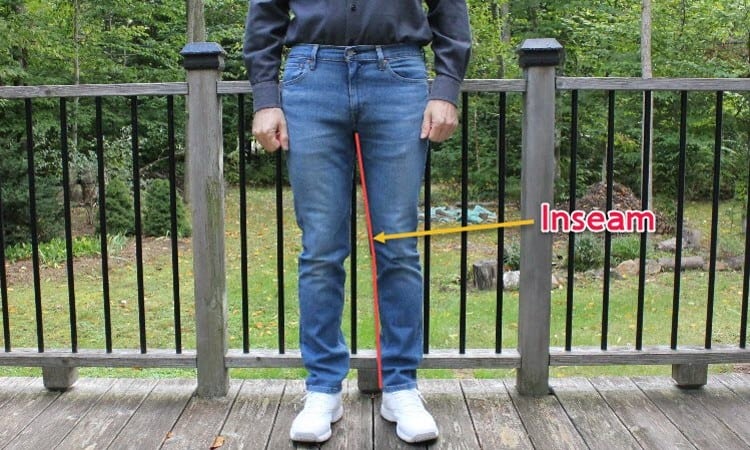
The second number listed as part of the size for men’s pants is the length. Technically, this measurement is called the inseam. It tells you the distance from the crotch seam to the hem along the inside of the leg.
The inseam measurement is quite straightforward.
- Place one end of a flexible tape measure at the point where the side seams meet the crotch seams in the pants you have on.
- Trace the tape down the inside of your leg to your ankle.
- Note down this measurement.
This is the length measurement you should look for listed as the second part of the pant size.
That said, the inseam measurement listed as part of the size may not match the length of the inseam in that pair of pants. This may seem confusing, but the manufacturer uses the size to tell you what leg size the pants should fit. If you get bootcut jeans, you will notice that the flared inseam includes an extra inch or so of distance, but the top-to-bottom length of the jeans does not change.
The bottom line is that if your body has an inseam measurement of 34 inches, you should look for pants that list “34” as the second part of the size.
3. Rise
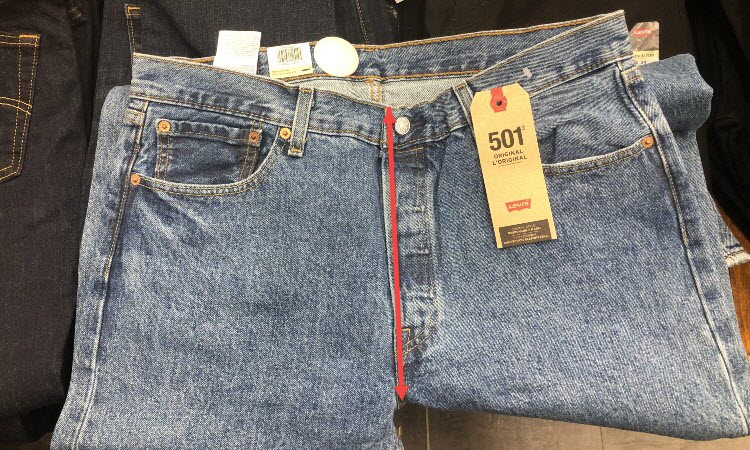
The rise on a pair of pants describes the distance between the top of the waistband and the crotch seam. You can have a front and back rise, and sometimes these measurements can have a significant difference between them. This tells you where the waistband will land on your body, such as high rise vs low rise.
On most pants, the front rise falls somewhere between seven to twelve inches.
The official size label for most pants does not include the rise measurement, but the sizing chart provided by the manufacturer should. This measurement matters greatly because it helps you understand how the pants will fit you.
For example, a seven-inch rise will place the waistband extremely low on your torso, but a twelve-inch rise will have the waistband above your navel.
To measure for pants rise:
- Wear close-fitting pants or bike shorts while taking this measurement.
- Stand with your feet slightly apart and your back straight.
- Hold one end of a flexible tape measure at the crotch seam of your pants.
- Trace the tape up your torso to a point slightly above your navel, at the point of your natural waistline.
4. Outseam
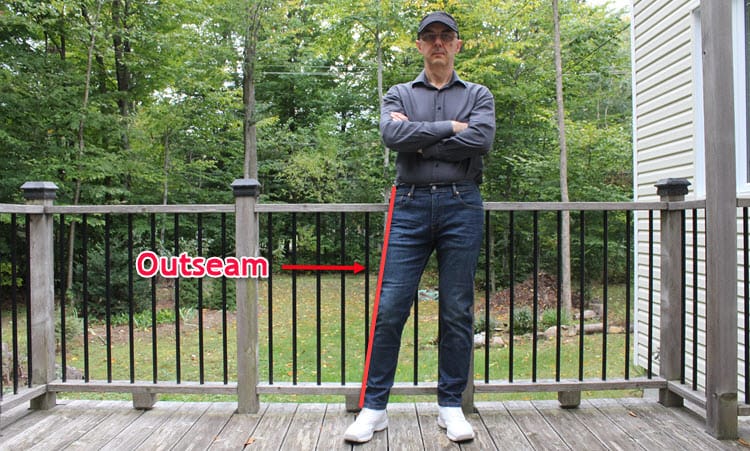
The outseam measures the length from the top of the waistband to the hem of the pants down the outer side of the pant leg. This measurement tells you the shape of the leg because a tapered leg will have a shorter outseam measurement than a flared leg.
Once again, the outseam measurement does not form part of the regular size label, which only lists the waist and length. But you can usually find this info listed in the sizing chart.
To take your own outseam measurement:
- Hold one end of a tape measure just above your hip, at your natural waistline.
- Let the tape fall to the floor
- Have a friend hold the tape to your ankle bone outside your leg and write down that measurement.
Pants Measurement Size Chart
Check out this chart to see the most common pants measurements for men’s trousers and jeans.
| Waist Size in Inches | Waist Size in CM | S, M, L |
| 28-30 | 71-76 | XS |
| 30-32 | 76-81 | S |
| 32-34 | 81-86 | M |
| 34-36 | 86-91 | L |
Does Length or Width Come First in Pants?
In the United States, men’s pants sizes list the width or circumference of the waist first and then the length or inseam of the pants.
Both numbers should match your body size when you measure the circle of your waist and the distance from your crotch to your ankle. The measurements may not reflect the actual size in inches of the pants, though!
Is a Men’s Size 34 a Medium or a Large?
Most brands list a 34-inch waist as a size large rather than a medium. But this can vary from one brand to another, so you should always check the sizing chart provided by the manufacturer if you plan to buy men’s pants that use a small, medium, and large sizing metric.
If you want to buy suits, trousers, khakis, or jeans, you will see the size listed as “waist measurement X length,” meaning that a “size 34” will tell you that the pants have a 34-inch waist in the size label.
Men’s Jeans Size Chart
Men’s jeans typically use the same sizing system as other men’s pants, with the waist size listed first and the length size listed second. Here you can see some common men’s jeans sizes compared to the small, medium, and large sizing system.
| Jeans Size | S, M, L Size |
| 27 X 30 to 30 X 30 | S |
| 30 X 32 to 32 X 32 | M |
| 32 X 34 to 35 X 32 | L |
| 36 X 34 to 38 X 34 | XL |
Common Men’s Pants Sizes Explained

Now that you understand how the sizing numbers in men’s pants sizes work, you may find answers to a few common size questions helpful.
What Does Pant Size 32×32 Mean?
In men’s pants, size 32 X 32 indicates pants that fit a person with a 32-inch natural waist and a 32-inch inseam. A 32” waist usually means a size medium in the small-medium-large sizing metric for men’s pants.
What Size is 32 in Men’s Pants?
A size 32 in men’s pants means pants that fit a man with a 32-inch waistline. This size usually correlates with a medium in casual men’s clothes like sweatpants. In European sizing, you would see this size listed as size 42.
What Size is a 32 Waist?
If you have a 32-inch waist, you need size 32 pants. Men’s pants sizes have a nice simplicity because your waist size is your pants size!
Of course, as you now know, men’s pant sizes almost always appear with two numbers. The waist measurement appears first, followed by the length measurement.
What Does 34×32 Mean in Pants?
In men’s pants sizes, 34 X 32 means pants that fit a man with a 34-inch natural waist and an inseam measuring 32 inches.
This size would equate to a Large in casual men’s pants, such as sweatpants from most brands.
What Does 36×34 Mean in Jeans?
Size 36 X 34 in men’s jeans means pants that will fit a man with a 36-inch waist circumference and a 34-inch inseam length. In the small-medium-large sizing system, a 36-inch waist usually correlates with a large or XL size.
What Size is 34 32 in Men’s?
A size 34 32 (or 34 X 32) in men’s pants or jeans means pants that fit a man with a 34-inch waistline and a 32-inch inseam length. In more casual pants, a 34-inch waist often means a size medium or large, depending on the brand.
How Tall is Someone Who Wears 34-Length Pants?
Men who wear pants with a 34-inch inseam usually stand between 6’ and 6’3” tall. The 34 length part of the size means that the pants should fit anyone with a 34-inch inseam or the distance between the crotch and the ankle on the inner leg.
What is a Size 14 in Men’s Pants?
If you convert a women’s size 14 to a men’s pants size, you will find that a 33-inch waist in men’s pants measures roughly the same as the 33” waist used in many women’s size 14 pants.
Men’s pants do not come in a “size 14” as there are not many men with a waist that measures 14 inches around!
Men’s to Women’s Pants Size Converter
You can make a rough conversion between men’s and women’s pants sizes by comparing the average waist sizes in women’s pants to the waist size listed in men’s pants sizes.
This is not a perfect science, though, because the measurements used to determine women’s clothing sizes can vary a lot from one brand to another. Also, keep in mind that men’s and women’s pants often have quite different shapes. Women’s pants tend to curve in the hips far more than men’s, for example.
That said, here is a look at the general lineup between men’s and women’s pants sizes in the United States:
| Women’s Pants Size | Average Waist Measurement for Women’s Pants | Men’s Waist Size/Pants Size |
| 2 | 26” | 26 |
| 4 | 27” | 27 |
| 6 | 28” | 28 |
| 8 | 29” | 29 |
European Pants Size Conversion Chart
The easiest way to convert a United States men’s pants size to a European men’s pants size is to add 16 to the United States waist size. This translates the inches used in United States sizes to the centimeters used in European sizes. For example, a “size 20” listed on a pair of European-made slacks would equate to a 36-inch waist on a pair of American-made trousers.
If you need to translate a European size into an American size, you can instead subtract 16 from the European measurement in centimeters.
However, this general rule of thumb may not always work, and here is why. Many European brands measure different areas of the body to determine sizes. Instead of measuring the circumference of the natural waist, they measure the distance from one hip to the other, not even around the torso!
This may lead to confusion if you shop for an Italian suit or jeans made in Paris. You may find it helpful to check out a sizing chart from these companies before making a purchase.
Most of the time, though, you can expect American and European men’s pants sizes to align like this:
| European Size | US Waist Size (first half of the pants size label) |
| 46 | 30 |
| 48 | 32 |
| 50 | 34 |
| 52 | 36 |
Conclusion
Men’s pants sizes use two numbers separated by an X, with the waist size listed first and the leg length listed second. The easiest way to buy the right size is to measure your waist and your inner leg and match your measurements to the waist in inseam numbers listed in the pants size. Keep in mind, though, that the size listed on the pants may not reflect the actual circumference of the pants’ waistband or the actual distance of the inseam of the pants.
The waist X length size system applies to most men’s pants, including jeans, trousers, and suit pants. But more casual legwear such as sweatpants or leggings may use a small, medium, and large metric instead. In this case, you should check the sizing chart provided by the brand to find the best fit.